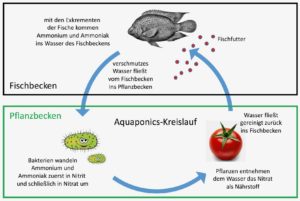 The tropical temperature in Panama is ideal for aquaponics systems.
The tropical temperature in Panama is ideal for aquaponics systems.- Tilapia is a warm water fish and therefore best suited for breeding.
- With a water saving of more than 90% in relation to conventional farming methods, large quantities of fish and vegetables can be produced naturally on small areas.
- Aquaponics becomes an essential part of our task in living together with the indigenous people of Panama.
For the operation of an Aquaponics system, the following components are particularly necessary:
- Water
- Oxygen
- Light
- Fish food
- Fish
- Plants
- Bacteria for nitrification
- Biofilters
- Energy for water pumps
- Containers for fish and plants
- Small stones in the hydroponics subsystem
- Pumps and pipes
An Aquaponics plant consists of the subsystems aquaculture (fish production) for the rearing of aquatic animals and hydroponics (plant production in water without soil) for the cultivation of plants. Biofilters are located between the two subsystems. While dung is added for the plants in hydroponics, excrements from aquaculture must be extracted from animals living in the water. Combining both systems in a symbiotic environment creates advantages for both.
The water of the aquaculture subsystem is polluted on the one hand by excrement from aquatic animals and on the other hand by uneaten feed. During decomposition of the fish jar ammonium and ammonia (NH3/NH4+) are formed. Ammonia is highly toxic to fish and is deadly even in small doses. The contaminated water from the aquaculture subsystem is therefore discharged into the hydroponics subsystem via biofilters, in which coarse impurities are clarified. If sufficient oxygen enters the water through the circulation, bacteria settle on all surfaces wetted with water within a short time. In order to make the surfaces as large as possible, small pebbles are inserted into the hydroponics subsystem and biofilters. The roots of the plants also have a large surface on which bacteria accumulate. Two groups of bacteria are required as nitrifiers or nitrifying bacteria. Nitrosomonas can convert ammonia into nitrite (NO2-) by oxidation – Nitrobacter decomposes the nitrite to nitrate (NO3-) in the second step.
While nitrite is harmful to fish because it does not bind oxygen, nitrates can be tolerated in certain concentrations. If the hydroponics subsystem is sufficiently planted, the nitrate as a nutrient is fully absorbed by the plants and the water can return to the aquaculture subsystem purified and enriched with oxygen. This cycle is continuous and enables hydroponic cultivation without the need for additional fertiliser and constant monitoring of the nutrient solution. In addition, fish farming is possible without the usual problems with water quality.
In tropical areas Tilapia is preferred for breeding because it is a species of warm water fish. The animals receive pure organic feed and the total absence of chemicals eliminates the problem of overfertilization of natural waters during disposal. Since there is no need for heating in Panama, power consumption is reduced to a minimum: only pumps have to be operated. Because it is a closed circuit, the water does not need to be replaced. Only evaporation losses, the extraction of biomass and the liquid absorption of the plants have to be compensated. An Aquaponics plant consumes only about 2% of the water that a conventionally irrigated farm needs for the same vegetable production. Furthermore, only very small areas are required to build a plant. For these reasons, aquaponic production of plants and fish is possible in areas where water or fertile land is scarce.
More importantly, aquaponic systems are generally free of weeds, pests and diseases, allowing them to produce consistently and quickly high quality products. As far as fruit and vegetables in the hydroponics subsystem are concerned, a very wide selection is possible. Since plants need different amounts of minerals and nutrients at different stages of growth, it is important to ensure that there are enough fish to be fed appropriately in order to produce enough faeces and that there are enough plants to absorb all nitrates. To the delight of environmentally conscious consumers, products from aquaponic systems are free of organic substances and pesticides and have a low ecological footprint.
Pool in the courtyard
In April 2017 I began to dig a basin in our yard. It will be 15 metres long, 10 metres wide and 3 metres deep. This corresponds to a volume of 450 cubic metres, which would suffice to irrigate our garden of about 5,000 square metres for a whole year. I will put fish in this basin after completion. As soon as the Aquaponics project has started, I will report on it regularly.
Aquaponics may be the most important sub-project at Finca Bayano!
